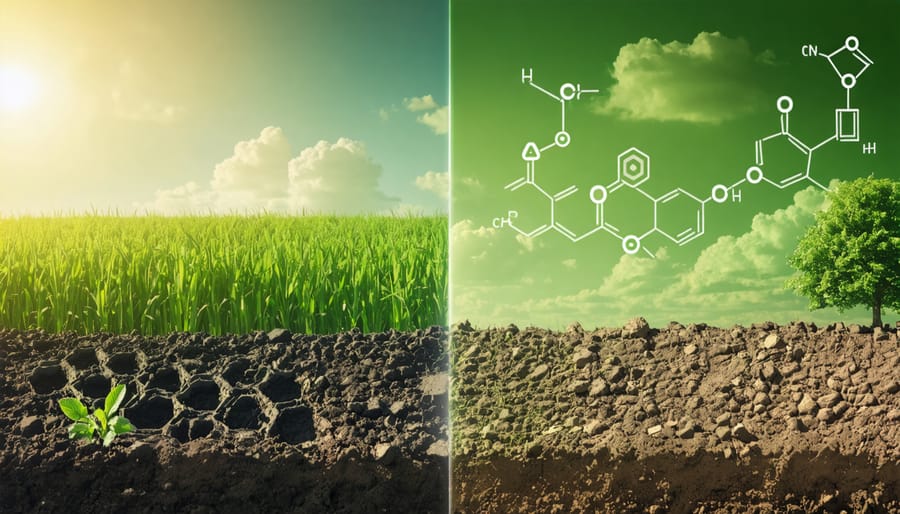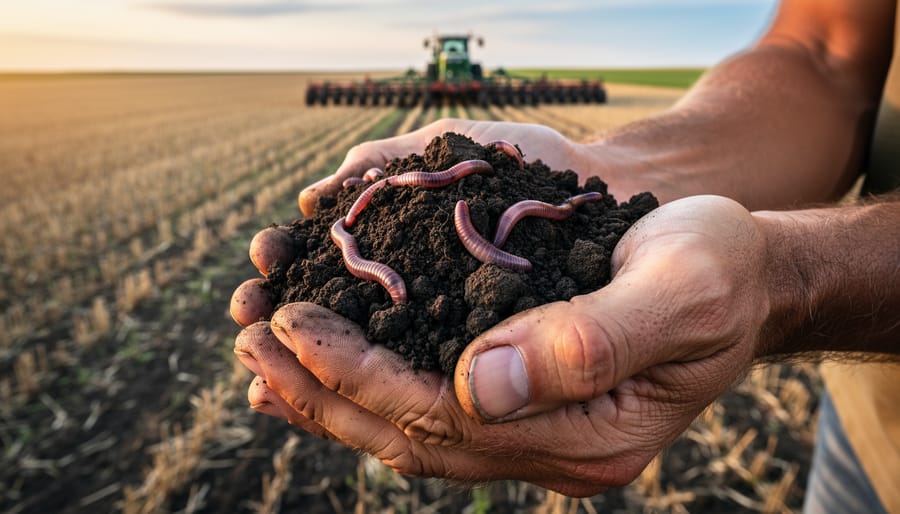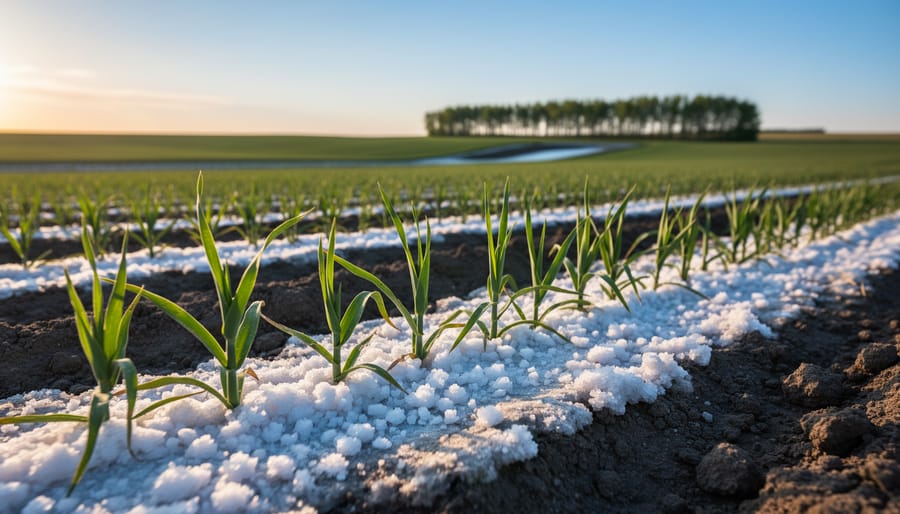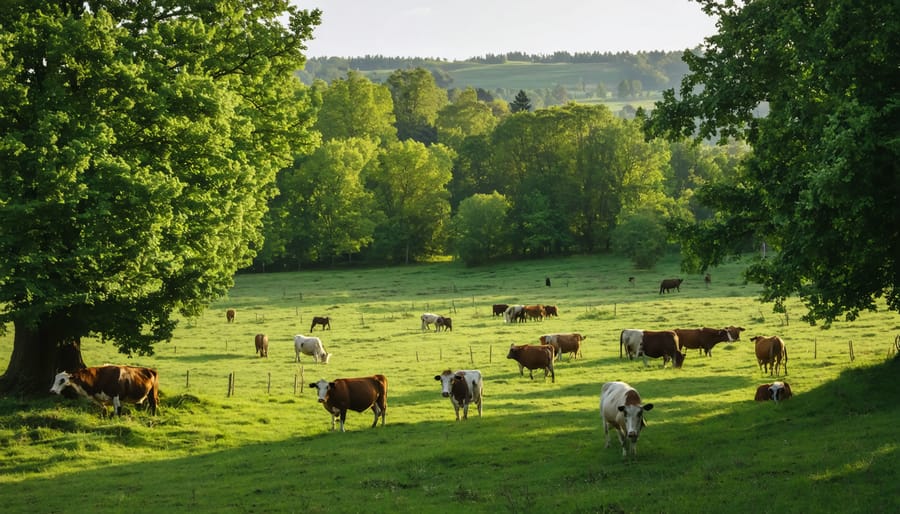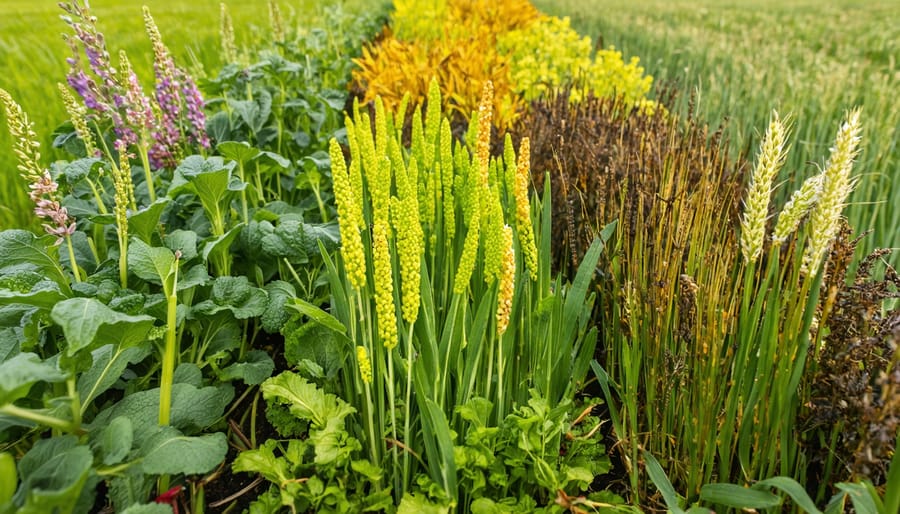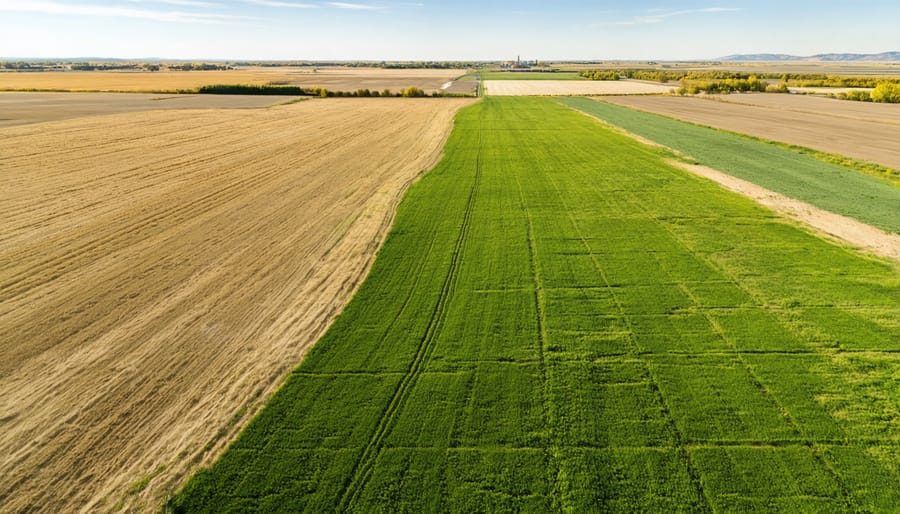Transforming exhausted farmland into thriving, productive soil becomes possible when revitalizing depleted soil with biochar. This carbon-rich material, created through pyrolysis of organic matter, has emerged as a game-changing solution for Alberta farmers facing challenging soil conditions. Recent studies from the University of Alberta demonstrate that biochar increases soil water retention by up to 30% and boosts crop yields by 15-20% in prairie conditions. Unlike traditional amendments, biochar’s benefits can last centuries, making it a long-term investment in soil health. As climate pressures mount and soil degradation concerns grow across Western Canada, this ancient technique, modernized for today’s agriculture, offers a sustainable path forward for Canadian farmers seeking to enhance their soil’s productivity while contributing to carbon sequestration efforts. Through careful application and integration with existing soil management practices, biochar presents a scientifically-proven method to improve soil structure, increase nutrient availability, and build lasting soil fertility.
The Science Behind Biochar’s Soil-Boosting Power
Structure and Composition
Biochar’s remarkable effectiveness in soil improvement stems from its unique physical structure. Picture a tiny, honeycomb-like material with countless microscopic holes and channels throughout. This porous nature creates an ideal environment for beneficial soil microorganisms and helps retain both water and nutrients.
In Alberta’s varying climate conditions, biochar’s structure proves particularly valuable. The material consists of about 70-90% carbon, arranged in a stable crystalline form that can persist in soil for hundreds of years. These carbon structures create millions of tiny pockets within the soil, ranging from 1 to 100 micrometres in size – perfect for holding water during our dry spells and providing shelter for beneficial bacteria and fungi.
What makes biochar truly special is its massive surface area. Just one gram of biochar can have a surface area of up to 400 square metres – that’s about the size of a basketball court! This extensive surface area allows biochar to act like a sponge, absorbing and slowly releasing nutrients while providing attachment sites for beneficial microorganisms.
For our Prairie soils, this means better water retention during dry periods, improved nutrient availability, and enhanced soil structure that helps prevent erosion during heavy rains or strong winds.
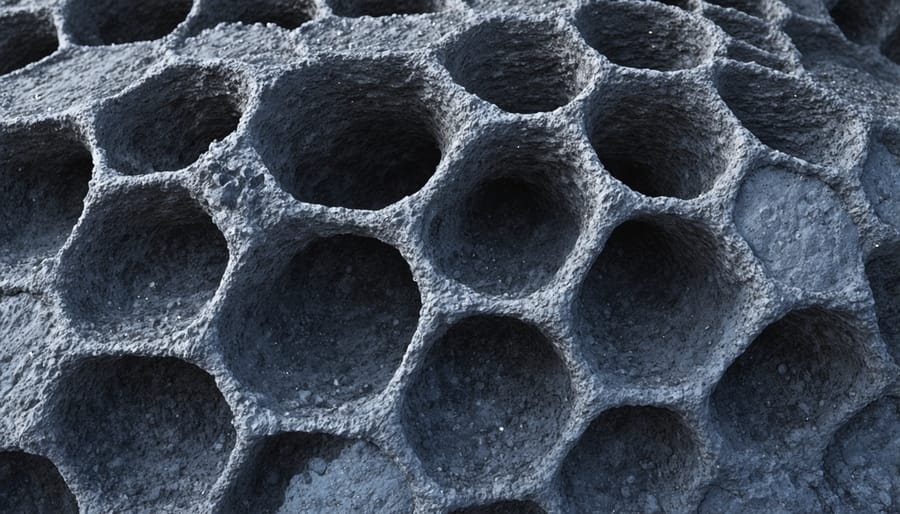
Chemical Properties
Biochar’s remarkable chemical properties make it a powerful soil amendment for Canadian farms. With a typically alkaline pH ranging from 7.5 to 9.5, biochar can help neutralize acidic soils common in parts of Alberta. Its unique molecular structure, characterized by a highly porous surface, creates an extensive network of sites that effectively capture and hold nutrients.
What sets biochar apart is its exceptional cation exchange capacity (CEC), which helps retain vital nutrients like calcium, magnesium, and potassium. This means fewer nutrients are lost through leaching, making your fertilizer applications more efficient and cost-effective. The stable carbon structure of biochar also works alongside soil organic matter to improve overall nutrient availability.
Biochar’s surface chemistry includes both negatively and positively charged sites, allowing it to hold onto different types of nutrients. This dual-charge nature means it can retain both positively charged nutrients like ammonium and negatively charged ones like nitrates and phosphates. For Alberta farmers dealing with sandy soils or intense rainfall periods, this nutrient-holding capacity can significantly reduce fertilizer washout while maintaining consistent nutrient availability for crops throughout the growing season.
Real Benefits for Alberta Farmers
Water Retention Enhancement
In Alberta’s challenging prairie climate, biochar has proven to be a game-changer for water management in agricultural soils. As a key component of modern drought-resistant farming practices, biochar’s porous structure acts like a natural sponge, capable of holding up to five times its weight in water.
Local farmers report significant improvements in soil moisture retention after incorporating biochar, with many noting extended periods between irrigation cycles. This is particularly valuable during our hot summer months when water conservation becomes crucial. The micropores in biochar create an ideal environment for water storage, releasing moisture gradually to plant roots as needed.
Research conducted at the University of Alberta shows that fields treated with biochar maintain consistent moisture levels up to 20% longer than untreated soils. This improved water retention not only helps crops survive dry spells but also reduces irrigation costs and promotes more efficient nutrient uptake. For every hectare treated with biochar, farmers can save approximately 20,000 litres of irrigation water per growing season.
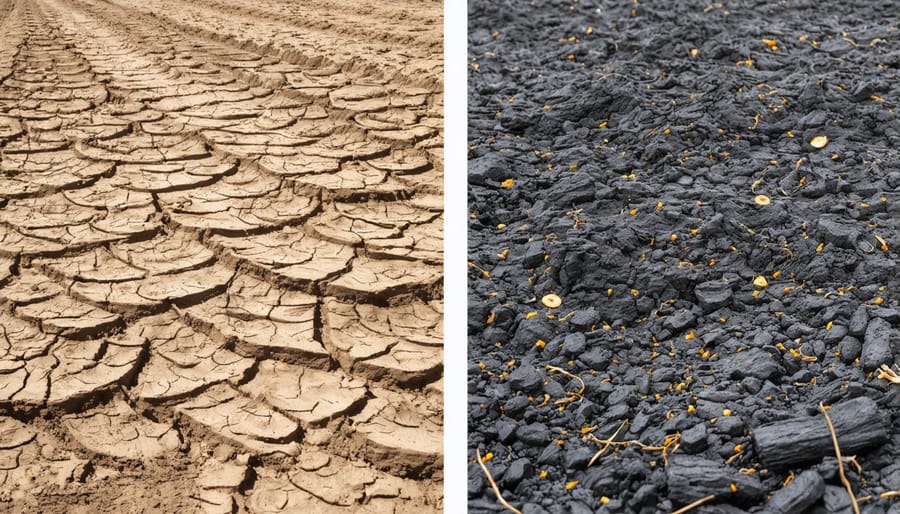
Nutrient Management
Biochar significantly enhances nutrient management in soil by acting as a natural fertilizer amplifier. When mixed with conventional fertilizers, biochar helps reduce nutrient leaching by up to 60%, allowing crops to utilize nutrients more efficiently. This means Alberta farmers can potentially decrease their fertilizer application rates while maintaining or even improving crop yields.
The porous structure of biochar creates an ideal habitat for beneficial soil microorganisms, which play a crucial role in nutrient cycling. These microscopic helpers break down organic matter and make nutrients more available to plants. Farmers in Red Deer County have reported using 30% less fertilizer after incorporating biochar into their soil management practices.
Biochar’s high surface area and negative charge help it hold onto positively charged nutrients like calcium, magnesium, and potassium. This retention capability is particularly valuable in sandy soils common in parts of Alberta, where nutrient loss through leaching is a significant concern. The material also helps stabilize soil pH, creating optimal conditions for nutrient availability.
Research at the University of Alberta shows that biochar-amended soils maintain higher levels of essential nutrients throughout the growing season, particularly during periods of heavy rainfall when nutrient loss typically occurs.
Carbon Sequestration Benefits
One of biochar’s most significant carbon sequestration benefits is its ability to lock carbon in soil for hundreds, even thousands of years. For Alberta farmers, this presents both environmental and economic advantages. When biochar is incorporated into soil, it stores carbon that would otherwise be released into the atmosphere, effectively creating a carbon sink on your farm.
Recent studies from Prairie soil research stations show that one hectare of biochar-amended soil can sequester between 3 to 5 tonnes of carbon dioxide equivalent annually. This carbon storage capability has caught the attention of carbon credit programs in Alberta, offering farmers new revenue streams while contributing to climate solutions.
Beyond carbon storage, biochar’s long-term presence in soil reduces the need for frequent reapplication, making it a cost-effective soil amendment over time. Many Alberta farmers report maintaining improved soil conditions for 5+ years after a single biochar application, resulting in decreased input costs and sustained yield improvements.
The stability of biochar in soil also means less tillage is required, further reducing operational costs and preserving soil structure. This combination of environmental stewardship and economic benefits makes biochar a practical choice for forward-thinking Canadian farmers.
Application Methods That Work
Preparation and Mixing
Before applying biochar to your soil, proper preparation is essential for maximizing its benefits. Start by crushing or grinding the biochar into particles roughly 2-5 mm in size – about the size of a grain of rice. This size allows for optimal soil integration while maintaining the biochar’s beneficial porous structure.
Next, charge your biochar by soaking it in a nutrient-rich solution for 24-48 hours. A common approach among Alberta farmers is mixing biochar with compost tea or liquid manure at a ratio of 1:5 (biochar to liquid). You can also blend it with your regular compost pile, allowing it to cure for 2-3 weeks before application.
For best results, combine your charged biochar with other organic materials. A successful mixture typically includes:
– 60% charged biochar
– 30% well-aged compost
– 10% mineral soil from your field
Many farmers in central Alberta have found success by adding a handful of native soil to this mixture, which helps introduce beneficial microorganisms specific to your land. When mixing, ensure even distribution and avoid creating dust by keeping the materials slightly damp.
Remember to wear appropriate protective gear, including a dust mask and gloves, during the preparation process. Store your prepared biochar mixture in a covered area protected from wind and rain until you’re ready for application.
Application Techniques
Biochar application methods vary depending on your farming system and goals. For smaller plots, you can mix biochar directly into the soil using basic farm equipment like tillers or disc harrows. Aim for an application rate of 5-10 tonnes per hectare for most crops, though rates can be adjusted based on your soil conditions.
For larger-scale operations, many Alberta farmers have found success using modified manure spreaders or specialized biochar applicators. Consider blending biochar with compost or livestock manure before application – this “charges” the biochar with nutrients and beneficial microorganisms, improving its effectiveness.
No-till farmers can apply biochar as a top dressing during the shoulder season, allowing natural processes to incorporate it into the soil over time. For best results in our prairie conditions, apply biochar in early spring or late fall when soil moisture levels are optimal.
When incorporating biochar into existing pastures, broadcasting followed by light harrowing has proven effective for many ranchers in central Alberta. For new plantings, try mixing biochar directly into your planting holes or rows.
Remember to moisten the biochar before application to prevent wind drift and ensure even distribution. If you’re new to biochar, start with a test plot of 1-2 hectares to evaluate its performance under your specific conditions before scaling up.

Success Stories from Alberta Farms
Grain Farm Transformation
A remarkable transformation occurred at the Henderson Family Farm, located just outside of Red Deer, Alberta, where third-generation farmer Mike Henderson implemented biochar on his 2,000-hectare grain operation. After three years of using biochar, Henderson reported a 23% increase in wheat yields and significant improvements in soil moisture retention.
“The difference was noticeable after the first season,” Henderson explains. “Our soil structure improved dramatically, and we’ve been able to reduce our irrigation needs by about 30%.” The farm initially applied biochar at a rate of 10 tonnes per hectare, incorporating it during their regular tillage operations.
The most striking change came during the drought of 2021, when Henderson’s fields maintained productivity while neighboring farms struggled. Soil tests revealed a 45% increase in organic matter content and improved nutrient availability, particularly in phosphorus and potassium levels.
The farm’s success has inspired other local producers to explore biochar applications. Henderson now hosts regular field days, sharing his experiences and application methods with fellow farmers. “The initial investment was significant,” he admits, “but the long-term benefits to soil health and crop yields have made it worthwhile for our operation.”
Market Garden Success
Market gardeners across Alberta have reported remarkable success with biochar integration in their intensive farming systems. Sarah Johnston, who operates a 2-hectare market garden near Red Deer, saw a 30% increase in vegetable yields after incorporating biochar at 5 kg per square metre. The moisture retention benefits proved especially valuable during dry spells, reducing irrigation needs by approximately 25%.
In community gardens around Edmonton, biochar has become increasingly popular for improving urban soil quality. These smaller plots benefit from biochar’s ability to enhance nutrient availability and support beneficial microorganisms, particularly important in spaces where soil may have been previously depleted or disturbed.
The Calgary Urban Growers Association documented that gardens using biochar-amended soil produced vegetables with better shelf life and more vibrant colours. Their test plots showed that root vegetables like carrots and potatoes developed more uniformly in biochar-enriched beds.
For greenhouse operations, biochar has proven particularly effective in container growing. Local greenhouse operator Mike Thompson notes, “We’ve cut our fertilizer use by 20% since adding biochar to our potting mix, and our tomato plants are healthier than ever.” This reduction in input costs while maintaining or improving yields makes biochar an attractive option for intensive growing operations.
The evidence is clear: biochar offers remarkable benefits for Canadian soil health and agricultural sustainability. From improved water retention and nutrient availability to enhanced microbial activity and carbon sequestration, biochar presents a compelling solution for farmers looking to boost their soil quality and crop yields while contributing to environmental stewardship.
Throughout Alberta and beyond, farmers who have incorporated biochar into their soil management practices report significant improvements in soil structure, reduced fertilizer needs, and better crop resilience during challenging weather conditions. These results demonstrate that biochar isn’t just an environmental choice – it’s a smart business decision that can lead to long-term cost savings and improved farm productivity.
As our agricultural community continues to face climate challenges and the need for sustainable practices grows, biochar stands out as a practical and proven solution. The initial investment in biochar can be offset by its long-lasting benefits and the potential for increased crop yields. Additionally, government programs and agricultural initiatives increasingly recognize biochar’s value, making it more accessible to Canadian farmers.
We encourage you to start small, perhaps with a test plot, and witness the benefits firsthand. Connect with local agricultural extension services or experienced biochar users in your area to learn from their experiences. By adopting biochar, you’re not just improving your soil – you’re investing in the future of sustainable Canadian agriculture.

